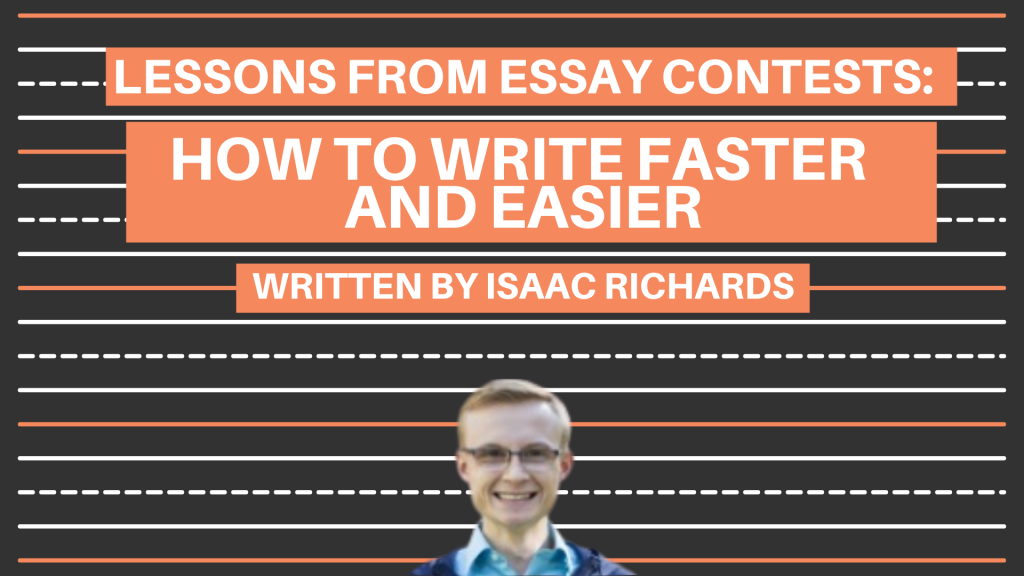Lessons From Essay Contests: How to Write Faster and Easier

Writing is hard.
Especially PR writing.
When I heard that PR students do a ton of writing, I pictured sitting at a clean desk with big windows, writing witty and delightful content that everyone loved.
I didn’t realize that PR writing was grueling, messy, frustrating work — the type of writing that makes revision feel like wrestling with your own words. PR writing often has to be done at a moment’s notice, at the end of the day, late at night, with a headache — oh and it has to be short and sweet and to the point and engaging and entertaining all at once!
However, there are a few tips that can make you a better writer. In fact, you may be doing too much writing.
This past semester, I won three essay awards in a row, and I realized that essay contest strategies can be utilized by PR professionals.
Whether it is landing an op-ed, getting published in a third-party blog, getting your writing featured by an influencer, or even pitching, the strategies I use for essay contests can make your writing process faster and easier.
Here’s what I learned:
Reading leads to the best writing.
“Good writers are avid readers,” says Harvard Psychologist Steven Pinker in his style guide, The Sense of Style. “Writers acquire their technique by spotting, savoring, and reverse-engineering examples of good prose.”
We all know that before pitching a journalist we should read their most recent articles to get an idea of their beat. What we don’t hear enough is that principle is true for all earned media! So, when a PR professional wants to submit content to a certain platform or channel, they should start by reading recent posts/articles first.
Four things to read before submitting content to a publisher:
1. Read the media request.
First things first: Read the media request! This could be a call for papers, invitation for posts, or a request for collaboration.
For each essay award I won, my first step was to read the prompt closely. What were they looking for? What content were they trying to generate? This phase of reading can be a source of inspiration for your writing.
2. Read mission statements.
Read your target channel’s mission, vision, and purpose to get a sense of what they would want to cover, and how you can mold your content to become something they want on their website.
Take notes.
One of my essay awards was from the Franklin S. Harris College of Fine Arts and Communications. Since they stress experiential learning, I included a story about experiential learning in my essay.
3. Read editor bios.
You can learn a lot about a media platform by learning about its editors. Editors are the gatekeepers to getting a blog post or op-ed published. If you know a bit about their backgrounds, you can include content that may appeal directly to them and make it easier for your writing to get past the screening process.
I noticed in one of my essay contests that the editor was a poetry professor, so I included some poetic conventions in my submission.
4. Read recent content.
The best way to get a sense of what content a blog or page is posting is by reading its most recent publications. When reading their recent content, look for topics, values, tone, and trends.
Jot down ideas.
Even before writing this article for Progressions, I read all the most recent blog posts!
Four ways to read before submitting a piece of content to a publisher:
1. Read for topics.
Reading with this intent can prepare a PR professional for any earned content: a brand deal, an influencer pitch, etc. Do they need new content on technology or social justice? What could your company offer?
Topics you notice can easily take shape in an outline.
2. Read for trends.
Do you notice anything consistent between posts or content pieces in your target channel? Do the editors seem to have an affinity for memes or cats or sports? Tie elements of those things into your content piece.
3. Read for values.
Does this platform prioritize minority voices? Cutting edge discoveries? Is their content from one side of the political spectrum more than the other? Look for what your target media channel values, and then incorporate those into the piece of content you submit to them.
Values make impact when included in conclusions.
4. Read for tone.
Websites, newspapers, blogs, social media pages, and influencers always have their own style or tone. To make it more likely for your media to get placed in their channel, watch for what their other content and posts sound like. Are they serious? Humorous?
Match it.
This can correspond with the drafting and revising stage of your writing as you work on your style and word choice.
Finished reading? Start writing!
After reading, you’ll look back at our notes and realize your writing process is almost over.
You brainstormed topics and chosen one. Crafted an outline based on topics and trends. Packed some powerful values into your conclusion, and already started revising for a consistent tone and style.
All you have to do now is pull it all together, proofread, and hit submit.
Like submitting to essay contests, submitting blog posts or editorials is always a bit of a gamble, so don’t make it harder or longer than it needs to be. Remember, the writing process is also a reading process. And good reading and research makes PR writing faster and easier.

Isaac Richards is a junior at Brigham Young University. He is majoring in Communications with an emphasis in Public Relations and minoring in both English and Professional Writing and Rhetoric. During the Fall 2020 semester, he won essay contest awards from the Mayhew Creative Arts Contest, the BYU Humanities and Social Justice Essay Contest, and the #CFAC Experience Essay Contest. Besides reading and writing, he also loves tennis and traveling.
